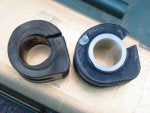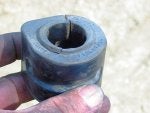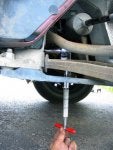I agree with you that this is the root cause of the problem, and I've postulated the notion before. But I do have some comments.
First, other vehicles share the same general design, that is the bar beginning a curve while still inside the bushing. The other vehicles with which I've worked don't have the same problem of continually wearing the bushing out. I believe the turn-in-the-bushing design is a factor, but not the only factor. I tend to believe that there are other geometrical forces at play here, but I don't know enough to even suggest what they might be.
Secondly, I do think the turn-in-the-bushing design is a bit of a necessary evil. Again, this is my uneducated opinion. On most cars with which I've dealt, the front sway bar shares the same type of design, and I believe it's to help center the bar on the chassis. My Dakota, Corolla, and T&C all have this same type of deal, where the bar begins to turn while still inside the bushing. The other two vehicles don't have the same problem that we have...constantly wearing these things out.
I believe this turn-in-the-bushing design is necessary because the end links are not laterally stable. That is, the end links themselves can rotate in 3 dimensions (twisting about a vertical axis, twisting about a horizontal axis, and everything in between). In other words, if you really loosened the frame bushings (or removed them entirely), the bar could easily slide back and forth to the left and to the right and the end links are mostly powerless to stop it.
Now, take for example the rear bar on these vans. The end links do not use a ball-and-socket joint like the front links do. They use a through bolt and a conventional bushing, like a shock absorber uses. While there can be some side-to-side movement of the bar here (which would be taken up entirely by the bushing, allowing the through bolt to deflect from horizontal), the bar would naturally equilbrate back to "centered". The front won't do that.
So while I agree that the problem lies in how far outboard the frame bushings of the front bar are in relation to the turns of the bar, I think it's designed necessarily so to keep the bar centered on the frame. Which means that I also agree with you that this is just something we have to live with (although I'm still not sure why this tends to be such a problem on these vans and apparently isn't a problem in other vehicles).











